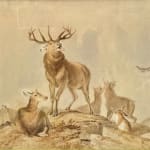Scottish School
Scene near Braemar
Watercolour
Size without frame 19 1/4 x 25 1/2 ins
Size with frame
Size with frame
£ 1,800.00
Further images
The artist of this watercolour is unknown but it is a copy of Sir Edwin Landseer's well known picture of the same, called Scene in Braemar.
"This picture is less consciously naturalistic and more obviously decorative and allegorical than many of Landseer's later deer subjects. It takes its name from the town of Braemar in the eastern Highlands, east of Ballater. Landseer often stayed at Mar Lodge, near Braemar, and hunted in the forests of Deeside.
A huge stag stands on a rocky eminence bellowing at the world in general. Grouped below are three hinds, one sitting meekly at his feet, two others gazing at a soaring eagle with prey in its talons. A white rabbit pops out of its hole on the right, a motif that suggested to one reviewer a fable from Aesop. The stag is depicted as an animal of supernatural power, a denizen of the wilds, heroic and majestic. It is silhouetted against a mountainscape, with wreathing mists suggesting a kind of sublime mystery.
The picture was admired at the time of its exhibition and remained one of Landseer's better known compositions." [Richard Ormond Sir Edwin Landseer 1981]
"This picture is less consciously naturalistic and more obviously decorative and allegorical than many of Landseer's later deer subjects. It takes its name from the town of Braemar in the eastern Highlands, east of Ballater. Landseer often stayed at Mar Lodge, near Braemar, and hunted in the forests of Deeside.
A huge stag stands on a rocky eminence bellowing at the world in general. Grouped below are three hinds, one sitting meekly at his feet, two others gazing at a soaring eagle with prey in its talons. A white rabbit pops out of its hole on the right, a motif that suggested to one reviewer a fable from Aesop. The stag is depicted as an animal of supernatural power, a denizen of the wilds, heroic and majestic. It is silhouetted against a mountainscape, with wreathing mists suggesting a kind of sublime mystery.
The picture was admired at the time of its exhibition and remained one of Landseer's better known compositions." [Richard Ormond Sir Edwin Landseer 1981]
Join our mailing list
McEwan Gallery Newsletter
* denotes required fields
We will process the personal data you have supplied in accordance with our privacy policy (available on request). You can unsubscribe or change your preferences at any time by clicking the link in our emails.





